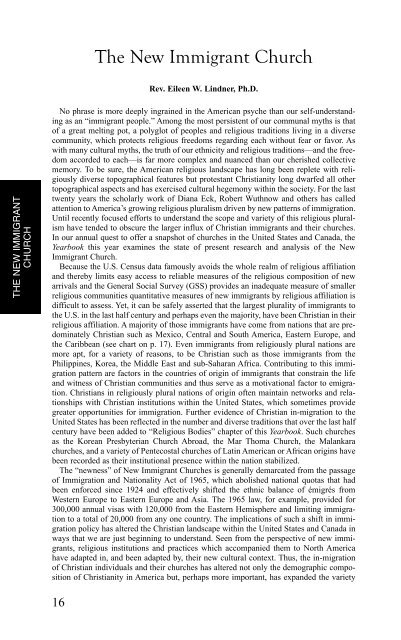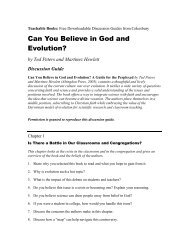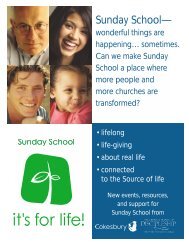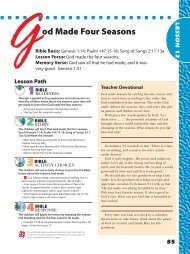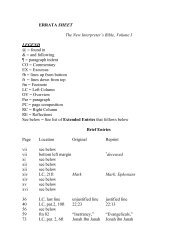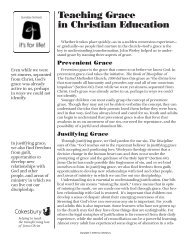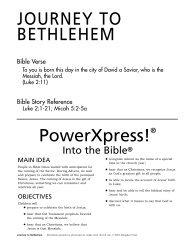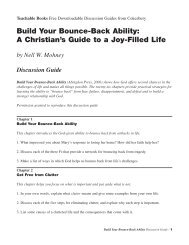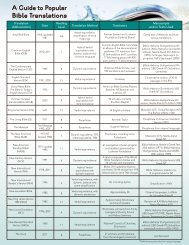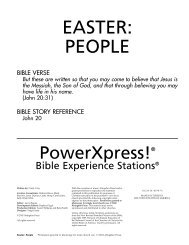Yearbook of American and Canadian Churches 2010 - Cokesbury
Yearbook of American and Canadian Churches 2010 - Cokesbury
Yearbook of American and Canadian Churches 2010 - Cokesbury
You also want an ePaper? Increase the reach of your titles
YUMPU automatically turns print PDFs into web optimized ePapers that Google loves.
The New Immigrant Church<br />
Rev. Eileen W. Lindner, Ph.D.<br />
THE NEW IMMIGRANT<br />
CHURCH<br />
No phrase is more deeply ingrained in the <strong>American</strong> psyche than our self-underst<strong>and</strong>ing<br />
as an “immigrant people.” Among the most persistent <strong>of</strong> our communal myths is that<br />
<strong>of</strong> a great melting pot, a polyglot <strong>of</strong> peoples <strong>and</strong> religious traditions living in a diverse<br />
community, which protects religious freedoms regarding each without fear or favor. As<br />
with many cultural myths, the truth <strong>of</strong> our ethnicity <strong>and</strong> religious traditions—<strong>and</strong> the freedom<br />
accorded to each—is far more complex <strong>and</strong> nuanced than our cherished collective<br />
memory. To be sure, the <strong>American</strong> religious l<strong>and</strong>scape has long been replete with religiously<br />
diverse topographical features but protestant Christianity long dwarfed all other<br />
topographical aspects <strong>and</strong> has exercised cultural hegemony within the society. For the last<br />
twenty years the scholarly work <strong>of</strong> Diana Eck, Robert Wuthnow <strong>and</strong> others has called<br />
attention to America’s growing religious pluralism driven by new patterns <strong>of</strong> immigration.<br />
Until recently focused efforts to underst<strong>and</strong> the scope <strong>and</strong> variety <strong>of</strong> this religious pluralism<br />
have tended to obscure the larger influx <strong>of</strong> Christian immigrants <strong>and</strong> their churches.<br />
In our annual quest to <strong>of</strong>fer a snapshot <strong>of</strong> churches in the United States <strong>and</strong> Canada, the<br />
<strong>Yearbook</strong> this year examines the state <strong>of</strong> present research <strong>and</strong> analysis <strong>of</strong> the New<br />
Immigrant Church.<br />
Because the U.S. Census data famously avoids the whole realm <strong>of</strong> religious affiliation<br />
<strong>and</strong> thereby limits easy access to reliable measures <strong>of</strong> the religious composition <strong>of</strong> new<br />
arrivals <strong>and</strong> the General Social Survey (GSS) provides an inadequate measure <strong>of</strong> smaller<br />
religious communities quantitative measures <strong>of</strong> new immigrants by religious affiliation is<br />
difficult to assess. Yet, it can be safely asserted that the largest plurality <strong>of</strong> immigrants to<br />
the U.S. in the last half century <strong>and</strong> perhaps even the majority, have been Christian in their<br />
religious affiliation. A majority <strong>of</strong> those immigrants have come from nations that are predominately<br />
Christian such as Mexico, Central <strong>and</strong> South America, Eastern Europe, <strong>and</strong><br />
the Caribbean (see chart on p. 17). Even immigrants from religiously plural nations are<br />
more apt, for a variety <strong>of</strong> reasons, to be Christian such as those immigrants from the<br />
Philippines, Korea, the Middle East <strong>and</strong> sub-Saharan Africa. Contributing to this immigration<br />
pattern are factors in the countries <strong>of</strong> origin <strong>of</strong> immigrants that constrain the life<br />
<strong>and</strong> witness <strong>of</strong> Christian communities <strong>and</strong> thus serve as a motivational factor to emigration.<br />
Christians in religiously plural nations <strong>of</strong> origin <strong>of</strong>ten maintain networks <strong>and</strong> relationships<br />
with Christian institutions within the United States, which sometimes provide<br />
greater opportunities for immigration. Further evidence <strong>of</strong> Christian in-migration to the<br />
United States has been reflected in the number <strong>and</strong> diverse traditions that over the last half<br />
century have been added to “Religious Bodies” chapter <strong>of</strong> this <strong>Yearbook</strong>. Such churches<br />
as the Korean Presbyterian Church Abroad, the Mar Thoma Church, the Malankara<br />
churches, <strong>and</strong> a variety <strong>of</strong> Pentecostal churches <strong>of</strong> Latin <strong>American</strong> or African origins have<br />
been recorded as their institutional presence within the nation stabilized.<br />
The “newness” <strong>of</strong> New Immigrant <strong>Churches</strong> is generally demarcated from the passage<br />
<strong>of</strong> Immigration <strong>and</strong> Nationality Act <strong>of</strong> 1965, which abolished national quotas that had<br />
been enforced since 1924 <strong>and</strong> effectively shifted the ethnic balance <strong>of</strong> émigrés from<br />
Western Europe to Eastern Europe <strong>and</strong> Asia. The 1965 law, for example, provided for<br />
300,000 annual visas with 120,000 from the Eastern Hemisphere <strong>and</strong> limiting immigration<br />
to a total <strong>of</strong> 20,000 from any one country. The implications <strong>of</strong> such a shift in immigration<br />
policy has altered the Christian l<strong>and</strong>scape within the United States <strong>and</strong> Canada in<br />
ways that we are just beginning to underst<strong>and</strong>. Seen from the perspective <strong>of</strong> new immigrants,<br />
religious institutions <strong>and</strong> practices which accompanied them to North America<br />
have adapted in, <strong>and</strong> been adapted by, their new cultural context. Thus, the in-migration<br />
<strong>of</strong> Christian individuals <strong>and</strong> their churches has altered not only the demographic composition<br />
<strong>of</strong> Christianity in America but, perhaps more important, has exp<strong>and</strong>ed the variety<br />
16


